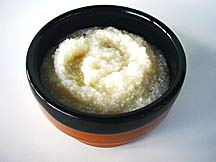|
Key Ingredient
|
Grits
 |
Just the word grits is a turnoff for many. At the same time, however, the simple dish is being elevated to gourmet status, finding itself on the menus of many upscale restaurants around the country.
The basics: Grits are made from ground, dried, white or yellow hominy corn. The dish dates back as far as 1607 when early colonists were offered hot bowls of softened ground corn by Native Americans.
How the dish got its name is unclear, but it probably refers to its gritty texture.
Grits were initially enjoyed at breakfast, but were also incorporated into other meals because they were inexpensive and filling. Grits are now a staple in the South, comparable to rice in Hawaii.
The dish has been compared to polenta, which is also made from cornmeal.
Selecting: Grits come in three forms -- fine, medium and coarse -- and is sold in regular, quick or instant forms similar to oatmeal.
As with oatmeal, the difference is in cooking time. Regular grits need 15 to 20 minutes of cooking, while instant can be prepared simply by adding hot water.
Storing: Grits should be stored in a cool, dry area and will keep for several months.
Use: The ground corn must be cooked in water or milk, with some salt, until it reaches a thick mushy consistency.
When using regular grits, some people choose to wash the grains, like washing rice to remove impurities.
Butter, cheese, cream or hot sauce may be added to cooked grits.
The dish may be served like a breakfast cereal or as a side dish at lunch or dinner.
Grits can also be incorporated into casseroles and stews, hardened and cut into squares and deep-fried, or added to cake and biscuit recipes. There's even a grits cheesecake recipe on the Internet!
Where to buy: Grits are available in most supermarkets next to other hot cereals such as oatmeal or cream of wheat. Prices vary depending on amount, but generally range from $2 to $3 a box.
![]()
a free-lance food writer. Contact her
online through features@starbulletin.com
[News] [Business] [Features] [Sports] [Editorial] [Do It Electric!]
[Classified Ads] [Search] [Subscribe] [Info] [Letter to Editor]
[Feedback]
